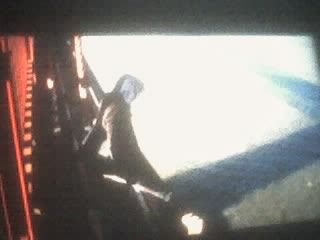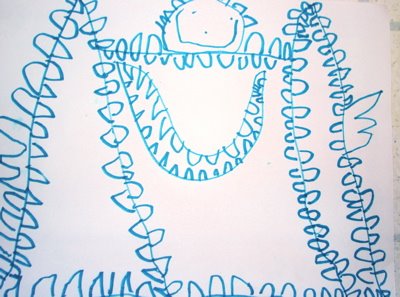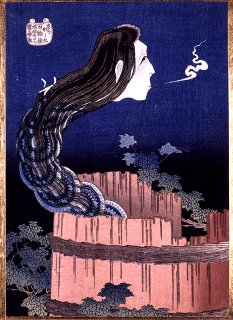
A year or so ago I read a story in the papers about a local filmmaker capturing people on camera as they jumped to their deaths off the Golden Gate Bridge. My first reaction to the idea of filmed suicides was, I admit, morbid fascination. I hoped it would be in theaters.
It would. "The Bridge" opened this past weekend, and I saw it.
Wow.Director Eric Steel trained his cameras on the bridge for an entire year and caught 23 of the 24 leapers, including a few more who tried and were stopped. Sometimes, while watching the film, you couldn't tell if the person you saw would turn out to be an innocent sightseer or a jumper. It felt creepy, and real. It
is real.
You see people on the bridge, mulling things over. You hear family members and friends talk about how hurt their loved one was over this life disappointment, or that turn of events. The survivors' voices carry their own burdens: Pain, guilt, rationalization, anger.
The parents of Philip Manicow, 22, almost seem at ease with their son's fate. Similarly, mother and sister of Lisa Smith, 44, sort of saw it coming. They reassure each other she's in a better place now, or at least free from pain.
A female friend of 52-year-old Daniel Rubenstein walks a tightrope of self-blame and excuse. When she discloses Rubenstein asked to stay at her house the night before he jumped, and that she turned him down, you sense there's more that's not being said. Friends of Gene Sprague, a 34-year-old unemployed computer gamer whose jump is easily the film's most chilling moment, are simply pissed. But he, too, repeatedly telegraphed the blow, and they ignored the signs.
Meanwhile, throughout the film, you're watching people jump. Whether captured in a closeup or seen as a distant, tiny splash in a wide-angle shot, each demise is equally creepy.
I was glad I didn't see the movie alone. After some deep breathing and a couple awkward jokes to lighten our mood, my friend and I talked aout what we'd seen over Thai food. We both really liked it, but had to think about why.
I was amazed that it was the only theatrical film I could think of that dealt specifically with the subject of suicide. It seems that while Americans are more aware than ever to the prevalence of mental illness, suicide -- unlike depression, bipolarism, post-traumatic stress disorder, etc. -- was still extremely taboo. My friend and I also liked how there weren't too many psychologists and therapists in the film. Although some "expert" voices may have been interesting, maybe even helpful to the viewer, their exclusion made the stories of the dead more visceral, unfettered.
Still, I was curious: The friends and family on screen weren't entirely blind to the loved ones' pain -- Sprague, for example, apparently joked for years about killing himself -- but you can't help asking: What could they have done? What should they have done? And what would I do?
I don't know. And I don't think this movie offers anything that helps answer these questions. It did get me to think about those things, think immensely about them, in fact. Every person has this incredible power to negate their existence. It's such a tremendous, terrible weapon.
My friend and I disagree on whether there should be a suicide barrier on the bridge. It's an active debate that wasn't mentioned in the movie. But Steel, the director, has gone on record to say he hopes "The Bridge" results in a barrier.
My friend didn't think some sort of safety net on the bridge would stop people from killing themselves because there's always other means. I had to agree. But it seems to me the Golden Gate is just too easy. More people kill themselves there than anywhere else in the country. It's too accessible, too cheap, and provides a false sense that jumping into water is clean and painless, when it's clearly neither. A barrier
might cause some people to turn back from suicide, because the other alternatives are harder or messier, and that could increase their chances to find help.
My main argument, however, is a purely selfish one, I don't want to be walking across the bridge with my kids some day and have them watch someone die. They don't need those nightmares, and I can't afford the therapy.
Anyway, when I came home I immediately hit the Web, eager to learn more about the movie and the people who jumped. In doing so, I came across some reviews that I found sort of surprising.
Some said it was not a good movie, that it feeded on our spectator culture, that it was irresponsible and that Steel, the director, sat by while people hurled themselves to their deaths when he could have stopped them. It turns out the director apparently didn't tell friends and family members he interviewed that the dead would actually be seen jumping to their death in the movie. And he also apparently fibbed while getting a state parks permit to film the bridge.
So I thought about those things. I'm sure a lot of people -- young people, mainly -- will watch this movie just to see people die (although the actual death part isn't really seen; its under water, and apparently very nasty and painful). Twenty years ago, I would have been in this group. However, given the void in material tackling the issue of suicide and the power of film in general, I think I can forgive "The Bridge" for being imperfect.
Suicides on the Golden Gate Bridge aren't private tragedies, they're happening right in front of you and me. The film uses these spectacles to its advantage. It pierces through the veil we've placed on suicide and delivers something more than an after-school special for adults. It dares us to do more by showing what is.
There really isn't anything brilliant about this movie. But in its simple, arresting and haunting way, "The Bridge" turns a doorknob to a room we've kept shut too long.





